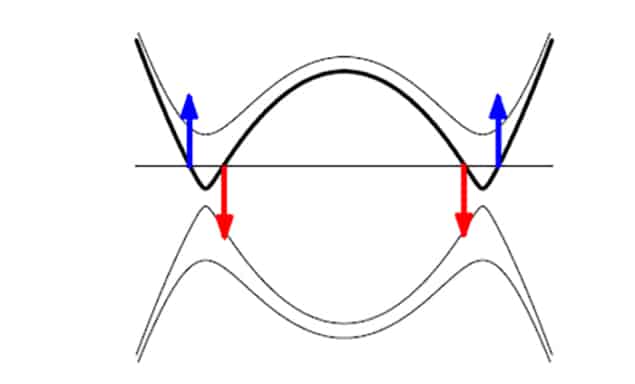
A new type of material called a “spin-valley half-metal” has been predicted by calculations done by physicists in Russia, Japan and the US. While the material has not yet been characterized in the laboratory, the team says it could find use in new types of biocompatible and carbon-based electronics.
Half-metals are materials in which only electrons with a specific spin polarization (spin-up, for example) participate in electrical conduction. These materials can therefore create currents with 100% spin polarization. This means that half-metals could be very useful for making spintronic devices – components that use the spin of the electron to store and process information.
Strong interactions
Materials that are known to be half-metals are compounds containing transition metals such as nickel and manganese. These elements ensure that there are strong interactions between conduction electrons, which result in the spin polarization. However, these metallic compounds are not suitable for several future applications of spintronics such as biocompatible electronics and devices based on carbon and organic molecules.
This latest work is by Alexander Rozhkov, Artem Sboychakov, Kliment Kugel and colleagues at the Institute for Theoretical and Applied Electrodynamics in Moscow, RIKEN in Japan and the University of Michigan in the US. The team has done calculations that suggest that half-metals can be made from compounds that do not contain transition metals.
The researchers focused on materials called spin-density wave insulators, which contain a microscopic periodic arrangement of regions with non-zero spin polarization. These materials have four energy bands that are characterized by the carrier charge (electron or hole) and the carrier spin (up or down). Such bands are often referred to as valleys and devices that try to exploit them for practical purposes are “valleytronics”.
Two valleys
Calculations done by Rozhkov and colleagues show that when certain spin-density wave insulators are doped by adding impurity atoms, two of the valleys will acquire charge carriers and therefore support electrical conduction. These two valleys can form the basis of a half-metal. Depending on the composition of the doped material, it can either be a conventional semi-metal or a new type of material that the researchers have dubbed a “spin-valley half-metal”.
Sboychakov says that it is now up to experimental physicists to try to create the doped compounds. “There are plenty of materials adequately described by the model we dealt with,” he says, “I am therefore convinced that the phase we predicted will eventually be discovered, either in a material that is available today or in one that is yet to be synthesized”.
The research is described in Physical Review Letters.



